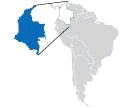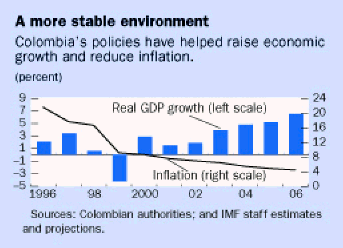
Typical street scene in Santa Ana, El Salvador. (Photo: iStock)
IMF Survey: Reform, Better Security Help Colombia
January 29, 2007
- Strong growth accompanied by large falls in unemployment and poverty
- Scope for reforms to reduce budget rigidities
- The authorities are tightening monetary and fiscal policies to limit overheating risk
Following its worst economic crisis in 30 years, Colombia has successfully turned the economy around.
Colombia at a glance

Capital: Bogota
Area: 1.142 million square km.
Population: 46 million
GDP per capita: $2,688 (2005)
Main products: oil, coal, coffee, precious metals, and light manufacturing products
FROM CRISIS TO RECOVERY
It has done so through a combination of fiscal reform and consolidation that has trimmed public debt, policies that substantially reduced inflation, and actions to strengthen the financial system. The policies that have been adopted since 1999, supported by three successive IMF arrangements, have sought to place the country on a path of sustainable growth and reduce inflation while substantially reducing poverty and unemployment. Since 2002, Colombia's economy has also benefited from a marked improvement in the security situation, although it remains a source of concern. After seven years of IMF economic programs, Colombia exited formal IMF support in November 2006 (see box).
Major reforms adopted, 1999-2006
Fiscal Policy
• Taxes. Several reforms boosted revenues from 17 percent of GDP in 2000 to about 21 percent of GDP in 2006.
• Fiscal decentralization. Laws approved in 2001-02 delinked intergovernmental transfers from current revenues and set spending and borrowing limits on territorial governments. In 2004, these entities began to run an overall surplus.
• Pension reform. Three reforms were approved in 2002-05 that raised contributions and trimmed benefits, and eliminated special regimes, including for teachers and the military. This reduced the actuarial deficit of the pension system from 200 percent of GDP in 2000 to 148 percent of GDP in 2005.
• Fiscal responsibility law. Since 2004, all levels of government have had to justify fiscal targets within a 10-year analysis of the sustainability of public debt.
• Public sector administration. Steps have been taken to streamline staffing and improve efficiency of the public health system and of public enterprises, including the state oil company, Ecopetrol, the telecommunications company; and the Cartagena oil refinery.
• Budget framework. After congress declined to approve the revised budget code, a 2005 decree implemented many of its elements.
Monetary policy
• Inflation targeting. Framework adopted in 2000.
Financial sector
• Privatization. Divested all but one public sector bank.
• Financial supervision. In 2006, a new financial regulatory agency was formed by merging the agencies in charge of supervising financial institutions and of securities. Provisioning levels brought up to international standards.
• Capital markets. A securities market law was approved in 2005 that strengthened clearing and settlement procedures, market integrity, and corporate governance.
Exchange system
• Exchange rate policy. In 1999, a flexible regime was adopted.
• Exchange restrictions. In 2004, Colombia accepted the obligations of the IMF's Article VIII, on exchange restrictions. Only one restriction is currently in effect, compared with four in 2004.
Economic recovery
After an initially slow recovery, real economic growth rose to 4 percent by 2004 and accelerated to an estimated 6½ percent in 2006, helped by strong private investment (see chart). This stronger growth, aided by a favorable global economy, has been accompanied by large declines in unemployment and poverty, as well as improved macroeconomic stability and a reduction of vulnerabilities (see table):
• With the recovery in the economy, unemployment declined from 20 percent in 2000 to about 12 percent in 2006, while poverty fell from 64 percent in 1999 to 49 percent in 2005.
• At the same time, inflation fell to its lowest level in decades, to about 4.5 percent in 2006, with the effective implementation of an inflation targeting framework.
• Aided by the fiscal reforms and increased oil prices, the combined public sector deficit was reduced from 5.5 percent of GDP in 1999 to a projected 0.4 percent of GDP in 2006. This performance—together with the real appreciation of the peso since 2004—helped reduce gross public debt from 57 percent of GDP in 2002 to 45 percent in 2006. In addition, public sector deposits reached an estimated 13 percent of GDP in 2006, up from 8 percent of GDP in 2002.
• Improvements in public debt management have reduced financing costs, diversified funding sources, lengthened the maturity of debt, lowered foreign exchange rate exposure, and enhanced liquidity in the domestic bond market. Since 2004, Colombia has issued about $1.6 billion of global peso-denominated bonds.
• The external sector strengthened, led by sustained growth in exports and a recovery in capital inflows. Net international reserves reached $15 billion (over 150 percent of short-term external debt at remaining maturity) in 2006.
• The health of the financial system recovered, as loan quality improved and bank profits increased. The nonfinancial corporate sector reduced leverage and managed currency risk more prudently, encouraged by the flexible exchange rate regime.

Tackling vulnerabilities
Colombia's medium-term economic prospects are broadly favorable. Sustained higher growth over the medium term is needed to raise living standards and reduce poverty more substantially. The authorities plan to sustain their economic policy strategy, which will likely be supported by a continued favorable external environment. Recognizing the critical importance for prosperity of maintaining low inflation, the authorities have already begun to tighten monetary and fiscal policies, to limit the risk that the economy may overheat. The authorities say they intend to address important policy challenges and continue to strengthen economic performance:
Public finances. The authorities will continue with fiscal consolidation to reduce further Colombia's public debt, which remains relatively high and a potential source of vulnerability. Congress is debating the government's proposal to reform the intergovernmental transfers system, which is crucial to contain future pressures on public finances and preserve the credibility of fiscal policy. There is also scope for reforms to lower other significant revenue earmarking and budget rigidities. At the same time, reducing tax distortions and broadening the tax system's base would be important to lower obstacles to more private investment while protecting revenue collections.
Financial system. Although the financial system is healthy, domestic capital markets need to be deepened and made more liquid. Less-developed capital markets, together with distortionary taxes on financial transactions (the stamp and financial transaction taxes), have contributed to the high cost of capital and deterred investment. The authorities are developing reforms to, among other things, strengthen creditor rights and improve credit bureaus. Steps to enhance the independence of the financial supervisory agency would be important to strengthen further the financial system.
Unemployment and poverty. The authorities are working to ensure that sustained growth translates into further declines in poverty, which remains high. One element will be to stimulate employment, which should, in turn, help reduce poverty. For this, it would be important to continue reforms to increase labor market flexibility and reduce still-high nonwage labor costs to spur job creation in the formal sector of the economy. More broadly, the authorities aim to reduce the poverty rate to 39 percent by 2010 and to 15 percent by 2019 while improving income equality. To this effect, a strategy seeking to extend coverage of primary education and basic health to the entire population by 2010 was launched in 2006. Other plans include doubling the size of Familias en Acción, an extremely successful program that provides nutrition and health care to families in extreme poverty.
|
| ||
|
2002 |
2006 | |
|
External sector |
||
|
Current account balance (percent of GDP) |
-1.7 |
-1.6 |
|
Net FDI inflows (percent of GDP) |
1.6 |
2.9 |
|
Gross international reserves in percent of short-term debt at remaining maturity1 |
103.3 |
153.3 |
|
Public sector |
||
|
Public sector gross debt (PSGD, in percent of GDP) |
57.0 |
44.5 |
|
Exposed to rollover risk (percent of total PSGD) |
12.0 |
9.7 |
|
Exposed to exchange rate risk (percent of total PSGD) |
56.3 |
44.4 |
|
Financial sector (FS) |
||
|
Nonperforming loans to total loans |
8.7 |
2.8 |
|
Foreign currency deposits held by residents (percent of total deposits) |
1.3 |
1.7 |
|
Government debt held by FS (percent of total FS assets) |
15.3 |
16.7 |
|
Sources: IMF staff estimates and projections; Colombian authorities. | ||







